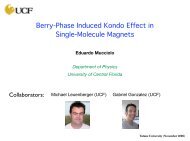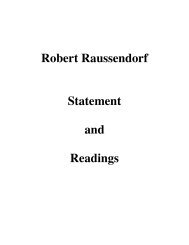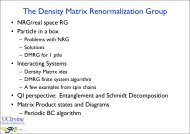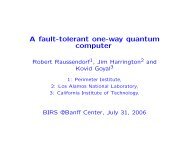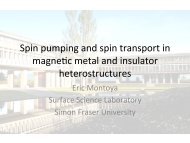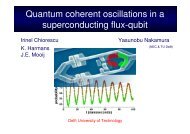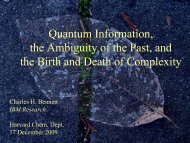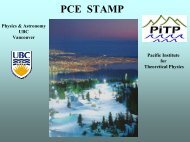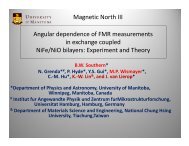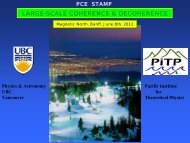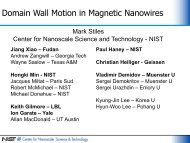Part 1 - PiTP
Part 1 - PiTP
Part 1 - PiTP
Create successful ePaper yourself
Turn your PDF publications into a flip-book with our unique Google optimized e-Paper software.
Computational Nano-Electronics<br />
Hong Guo<br />
Centre for the Physics of Materials and Department of Physics, McGill University,<br />
Montreal, QC H3A 2T8 Canada<br />
9nm<br />
Quantum Physics<br />
Eigler (IBM)<br />
Atomic Details<br />
Williams (HP)<br />
13/07/07 CIAR Summer Workshop, UBC, June 29, 2007<br />
page 1
Acknowledgements:<br />
Dr. Jeremy Taylor AtomistiX, Denmark mcdcal ver.1<br />
Prof. Jian Wang Univ. of Hong Kong NEGF theory<br />
Dr. Brian Larade QuantuModeling mcdcal ver.2<br />
Derek Waldron McGill matdcal<br />
Dr. Pawel Pomorski. Western Ontario capacitance<br />
Dr. Hatem Mehrez General Electric nanowires<br />
Dr. Devrim Guclu Cornell University Quantum dots<br />
Dr. C.C. Kaun Academic Sinica, Taipei Molecular wires<br />
Dr. Eric Zhu McGill transient, statistical<br />
Dr. Nikolai Sergueev UT-Austin electron-phonon at nonequilibrium<br />
Dr. Dan Roubtsov Chalk River National Lab inelastic current<br />
Prof. Q.R. Zheng Grad. School, CAS, Beijing Molecular electronics<br />
Prof. Wengang Lu Institute of Physics, CAS, Beijing nanotubes and molecular wires<br />
Dr. C. C. Wan, Dr. N.J. Zhu Synopsis Transport theory<br />
Dr. Jose-Luis Mozos Barcelona DFT-Scattering Matrix<br />
Guo group: Hu, Ji, Waldron, Couture, Ning, Ke, Massen, Drs. Timochevski, Liu, Wu, Zahid<br />
Paul Haney, Prof. Allan MacDonald (UT-Austin), Prof. Xia Ke & H.J. Gao (IoP) spintronics<br />
13/07/07 CIAR Summer Workshop, UBC, June 29, 2007<br />
page 2
Outline:<br />
• A review of state-of-the-art;<br />
• DFT atomistic methods;<br />
• The NEGF-DFT implementation details;<br />
• Some applications of NEGF-DFT;<br />
• Quantum mechanic forces during current flow;<br />
• Summary: outlook to the near future.<br />
13/07/07 CIAR Summer Workshop, UBC, June 29, 2007<br />
page 3
Quantum transport model (recall Prof. Datta’s lectures):<br />
µ L<br />
empty<br />
µ R<br />
Under a voltage bias, electrons<br />
ballistically traverse device from<br />
left to right. They are “hot”<br />
electrons on the right, and some<br />
dissipation occurs and electrons<br />
end up inside the right reservoir.<br />
Left<br />
reservoir<br />
Right<br />
reservoir<br />
We compute the transmission<br />
process from left to the right.<br />
+$<br />
( f f )<br />
e dE<br />
I ( V ) = ! # T ( E,<br />
" V ) !<br />
h 2%<br />
l<br />
!$<br />
r<br />
13/07/07 CIAR Summer Workshop, UBC, June 29, 2007<br />
page 4
A few starting remarks:<br />
• To do atomistic calculations of electric current (non-equilibrium), an<br />
important physics consideration is the non-equilibrium statistics of the<br />
scattering region.<br />
• A important practical consideration is the device Hamiltonian H. H<br />
determines the energy levels of the device. How to fill these levels is given<br />
by the non-equilibrium statistics.<br />
• Nonequilibrium statistics: NEGF, time-dependent evolution of density matrix<br />
from some initial condition, …<br />
• What H to use is a matter of numerical accuracy: effective mass, TB, HF,<br />
DFT, QMC, CI… In the end, one has to compare with real data.<br />
13/07/07 CIAR Summer Workshop, UBC, June 29, 2007<br />
page 5
So, the basic ingredients to start a theory:<br />
1. A transport model;<br />
2. Atomic Hamiltonian;<br />
3. Nonequilibrium Physics;<br />
4. Transmission;<br />
5. Fermi level alignment;<br />
6. Calculable.<br />
From: Nizan & Ratner, Science, 300, 1384 (2003).<br />
13/07/07 CIAR Summer Workshop, UBC, June 29, 2007<br />
page 6
Again: Landauer-Buttiker transport model<br />
It’s a scattering problem:<br />
+$<br />
( f f )<br />
e dE<br />
I ( V ) = ! # T ( E,<br />
" V ) !<br />
h 2%<br />
l<br />
!$<br />
r<br />
13/07/07 CIAR Summer Workshop, UBC, June 29, 2007<br />
page 7
Transmission coefficients:<br />
T ( E,<br />
" V ) = Tr[<br />
G<br />
r<br />
! G<br />
a<br />
!<br />
L R<br />
]<br />
(This is one of several ways of getting T)<br />
13/07/07 CIAR Summer Workshop, UBC, June 29, 2007<br />
page 8
Non-equilibrium Physics<br />
• Non-equilibrium means the statistical distribution of quasi-particles is<br />
NOT a Fermi-Dirac function.<br />
• For a device described by H=H 0<br />
+ V, where V causes nonequilibrium,<br />
one may solve the equilibrium part H 0<br />
first, then add V<br />
using a perturbation type approach. In many-body theory, such an<br />
approach leads to non-equilibrium Green’s functions (NEGF). NEGF<br />
is most convenient to derive formula for transport problems.<br />
• One may also evolve the density matrix of the entire H in time from<br />
the initial condition of equilibrium density matrix of H 0.<br />
13/07/07 CIAR Summer Workshop, UBC, June 29, 2007<br />
page 9
Equilibrium vs Non-equilibrium: adiabatic turning on<br />
H 0<br />
H=H 0 + V<br />
G(t 1 ,t 2 )<br />
t 1 t 2<br />
t=0<br />
H 0<br />
t<br />
H=H 0 + V<br />
G(t 1 ,t 2 )<br />
H 0<br />
H 0<br />
t 1<br />
t 2<br />
t=0<br />
t<br />
13/07/07 CIAR Summer Workshop, UBC, June 29, 2007<br />
page 10
Non-equilibrium: 4 basic Green’s functions<br />
t t’<br />
H 0<br />
t<br />
H 0<br />
t’<br />
H 0<br />
t’<br />
t<br />
t’<br />
t<br />
t=0<br />
t=0<br />
t=0<br />
t=0<br />
G ++ (t,t’)<br />
G +- (t,t’)=G <<br />
G -+ (t,t’)=G ><br />
G -- (t,t’)<br />
t<br />
t<br />
t<br />
t<br />
13/07/07 CIAR Summer Workshop, UBC, June 29, 2007<br />
page 11
Computing Hamiltonian for a device:<br />
Electronic Hamiltonian in Born-Oppenheimer Approximation:<br />
) 2<br />
2<br />
2<br />
2 1 e<br />
Z e &<br />
I<br />
'<br />
ri $ ! ( r;<br />
R)<br />
= Eel(<br />
R)<br />
! ( r;<br />
R)<br />
'<br />
* h<br />
, + + , * ,<br />
2me<br />
i 2 i-<br />
j 4"#<br />
, 4<br />
0<br />
r r i I "#<br />
0<br />
ri<br />
* R<br />
(<br />
i<br />
*<br />
j<br />
I $ %<br />
I,J label atoms with positions R I<br />
, R J;<br />
i,j label electrons with positions r i<br />
, r j<br />
This is a many-body problem impossible to solve exactly. Approximations are<br />
needed: for example apply LSDA to density functional theory (DFT).<br />
DFT treats e-e interaction in a mean field manner: each electron is moving inside a<br />
mean field created by all other electrons. Hence, instead of solving an N-particle<br />
problem, DFT solves N 1-particle problems self-consistently.<br />
A typical DFT calculation with LSDA or GGA can solve a system of a few tens to a<br />
few hundred atoms reasonably accurately for many situations, using a modest<br />
computer facility.<br />
13/07/07 CIAR Summer Workshop, UBC, June 29, 2007<br />
page 12
The Kohn-Sham (KS) equation:<br />
Assuming:<br />
Can always write:<br />
Obtain:<br />
Where:<br />
KS equation: solve an eigenvalue<br />
problem to build the Hamiltonian<br />
13/07/07 CIAR Summer Workshop, UBC, June 29, 2007<br />
page 13
Back to non-equilibrium transport situation:<br />
• KS equation of DFT comes from a variation principle by minimizing some<br />
total energy (good for equilibrium).<br />
• For non-equilibrium transport, it would be nice if some variational<br />
Lyaponov functional could be found. But so far no luck.<br />
Ansatz:<br />
Assuming Hamiltonian of device still has a KS form, but plug in a non-equilibrium<br />
density ! This choice of H has obvious terms, it also has various right limits when going<br />
back to equilibrium. The resulting outcome is not a ground state anymore because the<br />
density used is not the equilibrium ground state density.<br />
13/07/07 CIAR Summer Workshop, UBC, June 29, 2007<br />
page 14
Practical implementations:<br />
• Tight binding (TB) Hamiltonian combined with a transport code;<br />
• Density functional theory (DFT) based Hamiltonian combined with<br />
Keldysh non-equilibrium Green’s functions (NEGF);<br />
• DFT Hamiltonian combined with scattering wavefunctions;<br />
• Time-dependent DFT adapted with open transport boundary<br />
condition;<br />
• Higher level electronic structure method with some transport code.<br />
13/07/07 CIAR Summer Workshop, UBC, June 29, 2007<br />
page 15
Modeling based on tight binding (TB) potential:<br />
The interaction potential between atoms are<br />
parametrized and not calculated during<br />
device modeling.<br />
Very fast and can deal with large number of atoms, say ~10,000 atoms<br />
or more.<br />
Problems: Not terribly accurate because Fermi level alignment has to be<br />
put in by hand. Parameters may not reflect quantum transport environment.<br />
Research topic: can we find TB models with transport emphasis Should<br />
the TB parameters change with bias<br />
13/07/07 CIAR Summer Workshop, UBC, June 29, 2007<br />
page 16
Plane wave DFT + transport analysis<br />
Computes Hamiltonian of the scattering region by<br />
DFT use planewave basis set. Afterward, use the<br />
computed Hamiltonian to analyze transport.<br />
Planewaves form a complete basis set, thus can be more accurate than<br />
small basis set methods.<br />
Problems: (i) needs periodic boundary condition thus difficult to naturally<br />
apply bias voltage. (ii) if using transfer matrix, computation is large and time<br />
consuming. (iii) if try to localize planewaves, atomic sphere approximation<br />
(ASA) is usually necessary, this is an “art”.<br />
Wan etal. APL, 71, 419(1997); Choi and Ihm, PRB, 59, 2267(1999)).<br />
13/07/07 CIAR Summer Workshop, UBC, June 29, 2007<br />
page 17
Planewave DFT within Lippmann-Schwinger Eqn.<br />
Dealing with open and nonequilibrium<br />
device systems using<br />
LS equation, compute scattering<br />
states, construct charge density,<br />
and iterate DFT.<br />
jellium<br />
jellium<br />
This is a nice method: planewaves, correct transport boundary condition,<br />
correct non-equilibrium physics, one-molecule in between two planar<br />
leads…<br />
Problems: (i) it appears that the device leads must be jellium; (ii) it appears<br />
to need very large computation due to algorithm issues: seems no one has<br />
simulated more than 50 atoms so far.<br />
Lang, PRB 52, 5335(1995); Tsukada, PRB 55, 4997(1997); Di Ventra & Lang, PRB 65, 045402 (2001).<br />
13/07/07 CIAR Summer Workshop, UBC, June 29, 2007<br />
page 18
Time dependent DFT with transport boundary condition<br />
Solving density matrix by time dependent DFT:<br />
Earlier attempts map open system into closed one to avoid leads, Di Ventra & Todrov, J.<br />
Phys. C. 16, 8025(2004); Burke etal PRL 94, 146803(2005).<br />
More recent TDDFT attempts to include leads:<br />
"!<br />
This functional Q accounts for all<br />
~ [ H,<br />
!]<br />
+ Q(<br />
!)<br />
" t<br />
dissipative terms including effects of<br />
open boundaries, electrodes, etc…<br />
This method can be useful, but it appears that actual implementation has been difficult to<br />
accomplish fully. Functional Q is set by some ansatz, and it appears to be very difficult to<br />
compute if atomic leads are included. It’s potential computation power is yet to be seen.<br />
Kurth etal PRB 72, 035308 (2005); Zheng etal PRB 75, 195127 (2007); Li & Yan PRB 75, 075114(2007).<br />
13/07/07 CIAR Summer Workshop, UBC, June 29, 2007<br />
page 19
NEGF-DFT<br />
NEGF:<br />
"<br />
1<br />
$ = 2 # i<br />
!<br />
dEG<br />
p<br />
G<br />
G<br />
R<br />
p<br />
=<br />
G<br />
( E,<br />
U ) =<br />
E "<br />
H<br />
R<br />
0<br />
!<br />
p<br />
1<br />
" eU "<br />
G<br />
V<br />
ps<br />
"<br />
A<br />
V<br />
xc<br />
"!<br />
R<br />
DFT<br />
p<br />
R<br />
! = i E;<br />
µ )!<br />
+<br />
l l<br />
R<br />
f ( i f ( E;<br />
l l , µ )<br />
r r ! r,<br />
r<br />
NEGF<br />
!( r )<br />
2<br />
$ U = # 4!"<br />
Correct non-equilibrium physics, correct transport boundary conditions,<br />
large systems (~500 atoms), Ĥeasiness of adding new physics (e-p).<br />
Problem: inversion of matrix dictates the use of small basis sets.<br />
Book of Jauho; book of Datta; Wang et al. PRL 82, 398(1999)<br />
13/07/07 CIAR Summer Workshop, UBC, June 29, 2007<br />
page 20
Existing NEGF-DFT type implementations:<br />
• Y. Xue, S. Datta and M.A. Ratner, JCP 115, 4292 (2001); Chem. Phys. 281, 151 (2002).<br />
(TB,Gaussian)<br />
• J. Taylor, H. Guo and J. Wang, Phys. Rev. B. 63, 245407 (2001); ibid, 63, 121104 (2001). (LCAO)<br />
• M. Brandbyge, J.-L. Mozos, P. Ordejon, J. Taylor, and K. Stokbro, Phys. Rev. B 65, 165401 (2002).<br />
• J.J. Palacios et.al., Phys. Rev. B 66, 035332 (2002). (Gaussian)<br />
• S.-H. Ke, H.U. Baranger and W. Yang, Phys. Rev. B 70, 085410 (2004). (LCAO)<br />
• S. Faleev et.al., Phys. Rev. B 71, 195422 (2005). (LMTO)<br />
• Lu etal, PRL (2005). (LCAO)<br />
• A.R. Rocha, et.al., Nature Materials 4, 335 (2005). (LCAO)<br />
• Darancet etal cond-mat/0611404 (GW correction)<br />
• …<br />
13/07/07 CIAR Summer Workshop, UBC, June 29, 2007<br />
page 21
What’s different between these NEGF-DFT codes <br />
• Basis: Gaussian, LCAO-Siesta or the like;<br />
• XC potentials: various GGA, LSDA, LDA, one GW;<br />
• The way of handling electro-static boundary conditions: solution of<br />
Poisson equation;<br />
• Pseudopotential: more or less the same;<br />
• Other numerical details (k-sampling, grids, etc).<br />
They make differences in final numbers, but give similar qualitative results.<br />
Several codes are checked against each other to some extent: e.g. McDcal vs<br />
transiesta; Duke code vs McDcal; Palacios code vs McDcal; etc.. But these checks<br />
were done on simple systems such as C60, Al wire or Au wires.<br />
More careful checks are still desired.<br />
13/07/07 CIAR Summer Workshop, UBC, June 29, 2007<br />
page 22
NEGF-DFT comparison to real data on alkanethiol wires: works<br />
Rn = Ro<br />
exp( ! n)<br />
From: Lee etal J. Phys. Chem. 108, 8742 (2004).<br />
13/07/07 CIAR Summer Workshop, UBC, June 29, 2007<br />
page 23
NEGF-DFT comparison to real data on gold-BDT junctions: problems<br />
Tao etal. Nano Lett 4, 267(2003).<br />
Experiment: measures large number of<br />
systems and average.<br />
Stokbro etal. Comput. Matter. Sci<br />
27,151(2003) . NEGF + LDA<br />
Delaney etal, PRL93,36805(2004)<br />
Cluster CI + Wigner function on boundary<br />
Bauschlicher Jr. etal. Chem. Phys. Lett<br />
388,427(2004). NEGF+B3PW91 or B3LYP<br />
Ning etal., PRB72, 155403(2005)<br />
NEGF+B3LYP + correction from UPS<br />
reference data<br />
Varga etal. PRL 98,76804(2007). Closed<br />
system with complex boundary potential<br />
0.85us<br />
~20us<br />
~0.05us<br />
3-5us<br />
0.6 – 0.9 us<br />
1.55us<br />
It appears to suggest<br />
that Fermi level<br />
alignment is critical<br />
for this problem.<br />
13/07/07 CIAR Summer Workshop, UBC, June 29, 2007<br />
page 24
NEGF-DFT statistical analysis of many wires: issue of contacts<br />
Statistical analysis of hundreds wires each having slight different contact geometry.<br />
NEGF-DFT (LDA)<br />
Hu etal PRL 95, 156803 (2005)<br />
Theory: Experiment:<br />
G = 0.0023g G = 0.0012 g<br />
Contact structure critical !<br />
13/07/07 CIAR Summer Workshop, UBC, June 29, 2007<br />
page 25
NEGF-DFT STM simulation: height reversal<br />
Theory from S. Datta<br />
group: K. Bevan etal.<br />
PRB (2007).<br />
Experiment: Wolkow<br />
etal. Chem. Phys.<br />
Lett. 365, 129(2002).<br />
Bias & set current<br />
-3V, 50pA<br />
-2V, 50pA<br />
Experimental height<br />
3.3 A<br />
2.6 A<br />
Theory height<br />
3.4 A<br />
2.5 A<br />
-1.2V, 50pA<br />
-0.25 A<br />
0.1A<br />
13/07/07 CIAR Summer Workshop, UBC, June 29, 2007<br />
page 26
Fe-MgO-Fe Tunnel Junction<br />
5-layer MgO, measured by Wulfhekel<br />
etal APL 78, p509 (2001).<br />
TMR for perfect interface: 4000%,<br />
oxidized interface: ~1000%.<br />
NEGF+LSDA, Waldron etal PRL 97, 226802 (2006).<br />
Experiment: ~200 to 800% percent<br />
achieved in the last 2 years.<br />
13/07/07 CIAR Summer Workshop, UBC, June 29, 2007<br />
page 27
NEGF-DFT for Spin Transfer Torque: atomic simulation<br />
Cu Co Cu Co Cu<br />
Haney etal. PRB (2007).<br />
13/07/07 CIAR Summer Workshop, UBC, June 29, 2007<br />
page 28
Gate leakage current in Si MOS structure:<br />
Typically one uses empirical<br />
Fowler-Nordheim (FN) formula<br />
to model tunnelling in MOS.<br />
By extracting parameters from<br />
NEGF-DFT analysis and use<br />
proper FN formula, one can predict<br />
leakage current from atomic point<br />
of view. FN result obtained this<br />
way agrees with direct result from<br />
NEGF-DFT.<br />
L. Liu etal, IEEE Proceeding (2006).<br />
13/07/07 CIAR Summer Workshop, UBC, June 29, 2007<br />
page 29
NEGF analysis for silicon based device<br />
• T. Rakshit.etc Nano Lett. 4,1803(2004)<br />
• Negative differential resistance(NDR) effect was found in this type of system.The<br />
polarity reverses due to reversed doping, which agrees with the experiment<br />
• Silicon Related paper: PRL95,206805(2005)<br />
13/07/07 CIAR Summer Workshop, UBC, June 29, 2007<br />
page 30
NEGF-DFT: capacitance of nano devices<br />
• P. Pomorsky, etal PRB69, 115418(2004)<br />
• A general implementation of NEGF to calculate the capacitance of nano deivces. A<br />
CNT-junciton was introduced as an example.<br />
• Capacitance related paper: PRB74,113310(2006)<br />
13/07/07 CIAR Summer Workshop, UBC, June 29, 2007<br />
page 31
NEGF calculation of current density profile in nano devices<br />
• Y. Xue and M. Ratner PRB 70, 81404(2004); Y, Liu & H.Guo, PRB 69,<br />
115401(2004).<br />
• Several molecular junctions were calculated to show how and where<br />
current actually flows through a device. Recent experiment appears to<br />
show that this is measurable.<br />
13/07/07 CIAR Summer Workshop, UBC, June 29, 2007<br />
page 32
NEGF analysis of CNT-metal junctions<br />
• Y.Xue,etc PRB70,205416(2004)<br />
• CNT-metal junctions were studied by NEGF, Several issues are discussed: Schottky barrier<br />
formation, band lineup and conductance versus length and coupling strength.<br />
• CNT related paper: PRB69,115401(2004), PRB73, 233402(2006), PRL98,76804(2007)<br />
13/07/07 CIAR Summer Workshop, UBC, June 29, 2007<br />
page 33
NEGF-DFT for spin transport in molecules<br />
• D. Waldron, etc PRL96,166804(2006).<br />
• Tunneling magnetic resistance (TMR) of<br />
spin polarized junctions can be<br />
calculated and compared to real data.<br />
• Related paper: PRL97,226802(2006),<br />
PRB73, 094439 (2006)<br />
• Several molecular magnetic tunnel<br />
junctions were fabricated and measured.<br />
• Interesting science here: how chemistry<br />
affect spin transport.<br />
13/07/07 CIAR Summer Workshop, UBC, June 29, 2007<br />
page 34
NEGF-DFT with electron-vibron interaction, IETS<br />
• M. Galperin, M. Ratner , A. Nitzan. Nano Lett. 9,1605(2004), electron-phonon coupling is<br />
introduced by a self-energy term into NEGF that can be computed self-consistently.<br />
• Related papers: PRB73,205404(2006), PRB74,75326(2006), PRB75, 155312(2007),<br />
PRL95,146803(2005), PRL96,255503(2006)…<br />
IETS<br />
C 60<br />
Sergueev, Roubtsov, Guo, PRL 95, 146803(2005). Sergueev, Demkov, Guo PRB (2007)<br />
13/07/07 CIAR Summer Workshop, UBC, June 29, 2007<br />
page 35
Transient currents: very big challenge<br />
How fast can a molecule turn on/off a current Capacitance<br />
Voltage<br />
pulse<br />
The time dependent current can actually be written in terms of NEGF using<br />
steady-state Hamiltonian as H 0 . As such the transient current becomes<br />
computable within the NEGF-DFT formalism.<br />
Recent TDDFT (by Chen of HKU) calculations show totally consistent results.<br />
E. Zhu etal PRB 71, 075317 (2005). Majecko etal PRB 74, 085324 (2006). G.H. Chen, private<br />
communicaiton (2007).<br />
13/07/07 CIAR Summer Workshop, UBC, June 29, 2007<br />
page 36
Some major lessons learned so far from state-of-the-art<br />
• Fermi level alignment can be critical for some devices. This is a very hard problem : a small error<br />
in charge transfer can make a big difference in alignment. Must pin down charge transfer.<br />
• Contact structure is critical for many situations. How can we ever know this detail with certainty <br />
• Coulomb blockade need to be considered for some situations.<br />
• Structures can change during current flow: some studies exist.<br />
• Details of DFT (SIC, XC, pseudoptential, basis, k-sampling, etc) can make quantitative difference--<br />
-easier improvements.<br />
• Lack of checking and benchmarking between different codes.<br />
• Not enough solid comparison with experimental data.<br />
• Lack of a self-consistent method that can compute large systems.<br />
• …<br />
13/07/07 CIAR Summer Workshop, UBC, June 29, 2007<br />
page 37
Hot spots in transmission: Fe/MgO/Fe<br />
For systems having periodic x-y extent,<br />
one must compute transmission for<br />
each (k x , k y ).<br />
Huge number of k-sampling must be<br />
made for numerical convergence.<br />
Waldron & Guo, preprint (2007).<br />
13/07/07 CIAR Summer Workshop, UBC, June 29, 2007<br />
page 38
Some summary remarks:<br />
• It appears that NEGF-DFT type formalism has emerged as the main theoretical tool for<br />
practical atomistic calculations of molecular electronics. The results are qualitative but can<br />
also be quantitative for some situations in comparison with measured data.<br />
• NEGF-DFT type formalism has direct connection to quantum transport theory which is<br />
usually done using NEGF (e.g. molecular superconducting tunnel junction).<br />
• It appears that people in NEGF-DFT are moving toward various practical applications of it,<br />
and are not working hard enough for its basic theoretical foundation.<br />
• Technical improvements are more often seen (SIC, GW, CI, etc…).<br />
• A potentially fruitful direction is the TDDFT type approach. There are several recent<br />
reports for extending TDDFT to open boundary problems so that transport becomes<br />
possible. Only a few real calculations exist so far, and even fewer (if at all) compare to<br />
measured data. But this is just the beginning and the real outcome is yet to be seen.<br />
• Size limit so far: a few hundred atoms.<br />
13/07/07 CIAR Summer Workshop, UBC, June 29, 2007<br />
page 39
Challenging theoretical problems:<br />
1. At single device level, thoroughly understand what works, what does not work, what’s the limit,<br />
how to improve, on formalisms which are practically calculable. I think NEGF-DFT-type and<br />
TDDFT-type are good starting point.<br />
2. How to add more correlations GW or something drastic like CI Computation becomes too<br />
complicated will discourage people.<br />
3. Truly far from equilibrium: transients, quantum dissipation etc.<br />
4. Large numbers: how can we go beyond devices with 500 atoms<br />
5. Solve the Fermi level alignment problem: more experimental data exist now.<br />
6. Solve the contact problem: find better linkers Switch to semiconductor leads Also a job for<br />
experimentalists.<br />
7. How to efficiently gate a molecular transport junction<br />
8. Finite temperature effects.<br />
13/07/07 CIAR Summer Workshop, UBC, June 29, 2007<br />
page 40
Challenging theory problems (cont.)<br />
• Multiple devices: how to connect them into some thing more<br />
interesting <strong>Part</strong>ially coherent addition of devices<br />
• Impurities: cannot always do “super-cell” type avrages. Need to<br />
develop efficient approaches like CPA, vertex correction, and<br />
implement them atomistically and at non-equilibrium level.<br />
• Biomolecules: long history of theory work but seems to be a mess<br />
(my lack of knowledge). How to efficiently deal with solvent effects<br />
while current is flowing<br />
• Hybrid systems: transport problems where molecules are interacting<br />
with other materials such as superconductors, magnets, etc.<br />
13/07/07 CIAR Summer Workshop, UBC, June 29, 2007<br />
page 41
The impact of molecular electronics goes way beyond itself<br />
materials,<br />
chemicals,<br />
molecules, ….<br />
atomic quantum modeling<br />
software with accuracy<br />
13/07/07 CIAR Summer Workshop, UBC, June 29, 2007<br />
page 42
Outline:<br />
• A short review of state-of-the-art;<br />
• DFT atomistic methods;<br />
• The NEGF-DFT implementation;<br />
• Applications of NEGF-DFT;<br />
• Quantum mechanic forces during current flow;<br />
• Summary: outlook to the near future.<br />
13/07/07 CIAR Summer Workshop, UBC, June 29, 2007<br />
page 43
Atomistic modeling of materials:<br />
• There are many electrons in a device: they interact via Coulomb interaction.<br />
Exact solution is impossible to obtain.<br />
• The de facto standard technique for atomistic calculation is DFT: DFT has<br />
been widely applied to solve problems of solid state physics, materials<br />
science, chemistry, molecular modeling, biological systems, drug design, …<br />
• DFT treats e-e interaction in a mean field manner: each electron is moving<br />
inside a mean field created by all other electrons. Hence, instead of solving an<br />
N-particle problem, DFT solves N 1-particle problem.<br />
• A typical DFT calculation can solve a system of a few tens to a few hundred<br />
atoms very accurately.<br />
13/07/07 CIAR Summer Workshop, UBC, June 29, 2007<br />
page 44
Basics for DFT and total energy methods:<br />
• The Schrödinger equation for an isolated system:<br />
say a molecule<br />
• Born-Oppenheimer approximation<br />
• The Variational Principle and Kohn-Sham equation<br />
• The Hellman-Feynman theorem<br />
• Molecular Mechanics and Molecular Dynamics<br />
13/07/07 CIAR Summer Workshop, UBC, June 29, 2007<br />
page 45
The Hamilton operator for a general system with n nuclei and N<br />
electrons<br />
• The Schrödinger equation is:<br />
H ˆ!<br />
( r,<br />
R)<br />
= E!<br />
( r,<br />
R)<br />
– with the Hamiltonian<br />
& 2<br />
2<br />
2<br />
$ ( ' ( +<br />
'<br />
+<br />
$<br />
' ) 2<br />
h<br />
2 h<br />
2 1 e<br />
Z<br />
Ie<br />
1<br />
) ) )<br />
)<br />
Z<br />
I<br />
Z<br />
ri<br />
RI<br />
2 m i<br />
I<br />
i* j<br />
'<br />
%<br />
e<br />
2M<br />
I<br />
2 4+,<br />
ri<br />
' rj<br />
i, I 4+,<br />
0<br />
ri<br />
RI<br />
2 I * J 4+,<br />
0<br />
R<br />
0<br />
Electron K.E.<br />
Nuclear K.E.<br />
Electron-electron interaction<br />
Nucleus-nucleus<br />
interaction<br />
J<br />
I<br />
2<br />
e<br />
' R<br />
Electron-nucleus interaction<br />
J<br />
#<br />
!<br />
!"<br />
I,J label atoms with positions R I<br />
, R J<br />
i,j label electrons with positions r i<br />
, r j<br />
13/07/07 CIAR Summer Workshop, UBC, June 29, 2007<br />
page 46
The Born-Oppenheimer Approximation<br />
• The large difference in mass between electron and nuclei allows us to separate<br />
the electronic and the nuclear problem (adiabatic approximation)<br />
• The interatomic forces and potential energy are determined by the electrons,<br />
which itself depends parametrically on the atomic structure<br />
• Within the Born-Oppenheimer approximation:<br />
Nuclear<br />
wavefunction<br />
Full<br />
wavefunction<br />
#( r , R)<br />
=" ( r;<br />
R)<br />
!(<br />
R)<br />
Electron<br />
coordinates<br />
Atomic (nuclear)<br />
positions<br />
Electron<br />
wavefunction for<br />
given nuclear<br />
positions R<br />
13/07/07 CIAR Summer Workshop, UBC, June 29, 2007<br />
page 47
The Born-Oppenheimer Approximation (cont.)<br />
• The effective potential for the nuclei is determined by solving the<br />
electronic Schrödinger equation and then adding in the nuclearnuclear<br />
repulsion:<br />
) 2<br />
2<br />
2<br />
2 1 e<br />
Z e &<br />
I<br />
'<br />
ri $ ! ( r;<br />
R)<br />
= Eel(<br />
R)<br />
! ( r;<br />
R)<br />
'<br />
* h<br />
, + + , * ,<br />
2me<br />
i 2 i-<br />
j 4"#<br />
, 4<br />
0<br />
r r i I "#<br />
0<br />
ri<br />
* R<br />
(<br />
i<br />
*<br />
j<br />
I $ %<br />
V<br />
eff<br />
( R)<br />
=<br />
E<br />
el<br />
( R)<br />
+<br />
1<br />
2<br />
Z<br />
Z<br />
e<br />
2<br />
I J<br />
!<br />
I " J 4$%<br />
0<br />
RI<br />
#<br />
R<br />
J<br />
I,J label atoms with positions R I<br />
, R J<br />
i,j label electrons with positions r i<br />
, r j<br />
This is a many-body problem impossible to solve exactly. Further<br />
approximations are needed: we will use density functional theory (DFT).<br />
13/07/07 CIAR Summer Workshop, UBC, June 29, 2007<br />
page 48
The theorem of Hohenberg-Kohn:<br />
However, no one knows what this total energy functional is. But we can<br />
always write it as:<br />
Kinetic Hartree External exchangecorrelation<br />
13/07/07 CIAR Summer Workshop, UBC, June 29, 2007<br />
page 49
Variational principle:<br />
• In the vast majority of cases the system moves on the ground-state<br />
potential surface, for which the electronic energy is the minimum<br />
possible:<br />
E ˆ<br />
el<br />
( R)<br />
= min ! H<br />
el(<br />
R)<br />
!<br />
;<br />
• The variational principle states that an approximate wave function<br />
has an energy which is above the exact energy.<br />
!<br />
!<br />
=1<br />
13/07/07 CIAR Summer Workshop, UBC, June 29, 2007<br />
page 50
The Kohn-Sham (KS) equation:<br />
Assuming:<br />
Can always write:<br />
Obtain:<br />
Where:<br />
KS equation: an<br />
eigenvalue problem<br />
13/07/07 CIAR Summer Workshop, UBC, June 29, 2007<br />
page 51
The Hartree potential:<br />
Hatree potential satisfies the Poisson equation:<br />
2<br />
$ V<br />
= # 4!"<br />
One has to solve this equation numerically. Usually one uses Fourier<br />
transform. But for device simulation (later), this equation must be solved<br />
subject to device electrostatic boundary conditions.<br />
13/07/07 CIAR Summer Workshop, UBC, June 29, 2007<br />
page 52
The Hellman-Feynman theorem:<br />
For computing forces we set :<br />
" !<br />
R<br />
13/07/07 CIAR Summer Workshop, UBC, June 29, 2007<br />
page 53
The total energy functional:<br />
The KS eigen-values<br />
13/07/07 CIAR Summer Workshop, UBC, June 29, 2007<br />
page 54
Summary of DFT computation procedure:<br />
• Step 1: Starting from some trial initial electron density, compute the KS<br />
potential which is a functional of density.<br />
• Step 2: Solve the KS equation to find KS single particle wavefunctions.<br />
• Step 3: Construct new electron density from the KS wavefunctions.<br />
• Step 4: Go back to Step 2 until numerical convergence is reached.<br />
• Step 5: From the obtained KS Hamiltonian, compute physical quantities<br />
of interest.<br />
13/07/07 CIAR Summer Workshop, UBC, June 29, 2007<br />
page 55
Detail 1: Local Density Approximation (LDA):<br />
So far all terms in the total energy and KS equation can be computed, the<br />
only unknown is the exchange-correlation (XC) potential and XC-energy<br />
functional. This functional is not known exactly, and approximations must be<br />
used.<br />
For uniform electron gas, XC term can be analytically derived at high<br />
electron density limit, and it is a function of charge density. For system with<br />
very low electron density, this term can also be derived. Thus one<br />
extrapolates between the high and low density limits---LDA.<br />
There are many forms of LDA.<br />
Other functionals such as Generalized Gradient Approximation (GGA) are<br />
also widely used.<br />
Book of Parr and Yang.<br />
13/07/07 CIAR Summer Workshop, UBC, June 29, 2007<br />
page 56
Example of LDA:<br />
Goedecker etal. PRB 54 1703(1996).<br />
13/07/07 CIAR Summer Workshop, UBC, June 29, 2007<br />
page 57
Detail 2: pesudopotential approximation<br />
There is another unknown potential in the KS equation named:<br />
A most important piece of this external potential is due to the<br />
atomic core. The core is the nuclei plus the close shell core<br />
electrons.<br />
Properties of materials are largely determined by valence electrons. For example,<br />
Therefore, to reduce calculation, we only<br />
focus on valence electrons and put the nuclei<br />
potential and core electron potential into a<br />
“pesudopotential”<br />
(r)<br />
V ps<br />
Ex: Au has 79 electrons, but only 11 valence<br />
electrons.<br />
13/07/07 CIAR Summer Workshop, UBC, June 29, 2007<br />
page 58
Periodic table:<br />
13/07/07 CIAR Summer Workshop, UBC, June 29, 2007<br />
page 59
Pseudopotentials:<br />
13/07/07 CIAR Summer Workshop, UBC, June 29, 2007<br />
page 60
Detail 3: Basis sets<br />
To solve the KS equation, we expand the KS wavefunction in terms of some<br />
basis sets. There are many choices of basis function: plane waves; LCAO;<br />
real-space girds, etc…<br />
Plane wave basis: this is very natural for periodic solid state systems where<br />
Bloch theorem holds,<br />
13/07/07 CIAR Summer Workshop, UBC, June 29, 2007<br />
page 61
Real space grids:<br />
Discretize the simulation box by real space grids:<br />
Very fine grids must be used. This<br />
basis makes program very simple<br />
and easy to code. The calculation is<br />
very large, but is gaining popularity<br />
in recent years.<br />
13/07/07 CIAR Summer Workshop, UBC, June 29, 2007<br />
page 62
Linear combination of atomic orbitals (LCAO):<br />
Solve the atomic orbitals of one atom, and use the atomic orbitals as basis.<br />
Thus the basis functions are centered at each atom. The atomic orbitals are<br />
written as:<br />
Therefore:<br />
µ = s d<br />
, px,<br />
py,<br />
pz,<br />
1!<br />
5<br />
13/07/07 CIAR Summer Workshop, UBC, June 29, 2007<br />
page 63
Atomic orbitals (cont.):<br />
To reduce calculation, we can cut off the radial atomic orbital:<br />
13/07/07 CIAR Summer Workshop, UBC, June 29, 2007<br />
page 64
LCAO (continue):<br />
The LCAO code is about the computation of these matrix elements.<br />
13/07/07 CIAR Summer Workshop, UBC, June 29, 2007<br />
page 65
Matrix elements in LCAO basis:<br />
13/07/07 CIAR Summer Workshop, UBC, June 29, 2007<br />
page 66
Matrix elements in s,p basis:<br />
13/07/07 CIAR Summer Workshop, UBC, June 29, 2007<br />
page 67
Comparison of basis sets;<br />
13/07/07 CIAR Summer Workshop, UBC, June 29, 2007<br />
page 68
Detail 4: solutions of the KS equation:<br />
or<br />
Because:<br />
Becomes a matrix eigenvalue problem.<br />
13/07/07 CIAR Summer Workshop, UBC, June 29, 2007<br />
page 69
Solution of KS equation (cont.):<br />
The most direct solution is by matrix diagonalization. If the basis set<br />
has functions, the matrix is N<br />
b<br />
! N b<br />
N b<br />
Matrix diagonalization scales as<br />
computation is huge.<br />
3<br />
N b<br />
, thus if one uses large basis sets, the<br />
For plane wave basis, typically we need 100 plane waves per electron. Thus<br />
for 1000 electrons, we have 100,000 plane waves. The matrix is very large<br />
indeed. But if we use LCAO, for s,p,d basis we have 9 orbitals per atom.<br />
Thus matrix size is rather small: for 100 atoms we have 900 basis functions.<br />
13/07/07 CIAR Summer Workshop, UBC, June 29, 2007<br />
page 70
Direct minimization of KS total energy:<br />
Since KS equation comes from minimization of the KS total energy, why not<br />
directly minimize the total energy<br />
KS total energy:<br />
KS equation<br />
steepest decent<br />
conjugate gradient<br />
13/07/07 CIAR Summer Workshop, UBC, June 29, 2007<br />
page 71
Review Literature on DFT details:<br />
13/07/07 CIAR Summer Workshop, UBC, June 29, 2007<br />
page 72
Summary of typical DFT implementation:<br />
• Basic theorem of Holhenberg-Kohn leads to KS-total energy functional, and variational<br />
principle leads to KS-equation.<br />
• With LDA (or GGA), all potential terms in KS-functional are determined by charge density.<br />
• Charge density matrix is obtained by KS-eigenstates which are computed by solving the<br />
KS-equation which is a self-consistent problem.<br />
• Several methods are available for solving KS-equation.<br />
• Further details of pseudopotentials, basis sets, boundary conditions, etc, are used to<br />
simplify numerics.<br />
• We obtain: Hamiltonian of the system and its electronic states. For solids, we obtain bandstructures.<br />
13/07/07 CIAR Summer Workshop, UBC, June 29, 2007<br />
page 73
Outline:<br />
• A short review of state-of-the-art;<br />
• DFT atomistic methods;<br />
• The NEGF-DFT for transport: implementation details;<br />
• Some applications of NEGF-DFT;<br />
• Quantum mechanic forces during current flow;<br />
• Summary: outlook to the near future.<br />
13/07/07 CIAR Summer Workshop, UBC, June 29, 2007<br />
page 74
NEGF-DFT: Taylor, Guo, Wang, PRB 63, 245407(2001)<br />
• Using density functional theory (DFT) to compute the electronic structure of the<br />
Ni-BDT-Ni device;<br />
• Using Keldysh non-equilibrium Green’s function (NEGF) to populate this<br />
electronic structure (quantum statistics);<br />
• Using real space numerical techniques to deal with the device boundary<br />
conditions.<br />
Note: conventional DFT solves two kinds of problems: isolated or periodic<br />
Periodic (VASP)<br />
Isolated (Gaussian)<br />
A device is neither isolated nor periodic<br />
13/07/07 CIAR Summer Workshop, UBC, June 29, 2007<br />
page 75
A device is an OPEN system:<br />
Two new problems must be solved:<br />
1. How to reduce the infinitely large system to something<br />
calculable on a computer<br />
2. How to compute charge density when there is an external<br />
bias potential (non-equilibrium)<br />
13/07/07 CIAR Summer Workshop, UBC, June 29, 2007<br />
page 76
Screen approximation---reducing the infinitely large problem:<br />
A device is “infinitely” large due to the large leads. So typically all<br />
theories divide the system into 3 parts: left/right leads and central region.<br />
Charge<br />
density<br />
Left lead<br />
Scattering region<br />
Right lead<br />
Within screen approx., we only have to worry about a finite scattering region .<br />
13/07/07 CIAR Summer Workshop, UBC, June 29, 2007<br />
page 77
Another example<br />
Using the screening<br />
approximation and solving<br />
Poisson Eq. in real space,<br />
we can deal with systems<br />
with different leads.<br />
13/07/07 CIAR Summer Workshop, UBC, June 29, 2007<br />
page 78
The Matdcal NEGF-DFT implementation<br />
• Matdcal---matlab based Device Calculator. It evolved from our<br />
earlier versions which were written in Fortran and C.<br />
• About 90% of Matdcal codes are written in matlab. The 10%<br />
numerical intensive parts is written in Java (will be migrated to<br />
C++).<br />
• A parallel toolbox is developed by wrapping MPI into C and called<br />
by matlab. The code is well parallelized to run on PC clusters<br />
efficiently. For typical calculations involving
Details: (1) Density matrix integration = !<br />
"<br />
1<br />
$ 2 # i<br />
dEG<br />
The NEGF has poles in both upper and lower half energy plane, as well as<br />
on the real axis. These poles represent electronic states of the device<br />
scattering region. Thus the energy integral in density matrix is impossible to<br />
do for most situations: the integrand has huge peaks at these poles.<br />
p<br />
Example: density of states<br />
(the integrand) of an 1d<br />
atomic wire: the sharp peaks<br />
give numerical trouble.<br />
13/07/07 CIAR Summer Workshop, UBC, June 29, 2007<br />
page 80
f l<br />
G<br />
p<br />
=<br />
Density matrix integration (cont.):<br />
G<br />
R<br />
!<br />
p<br />
G<br />
A<br />
f r<br />
p<br />
R<br />
! = i E;<br />
µ )!<br />
+<br />
l l<br />
G<br />
R<br />
"<br />
( E,<br />
U ) =<br />
E "<br />
1<br />
$ = 2 # i<br />
H<br />
0<br />
1<br />
" eU "<br />
V<br />
!<br />
ps<br />
"<br />
dEG<br />
R<br />
f ( i f ( E;<br />
l l , µ )<br />
r r ! r,<br />
r<br />
V<br />
xc<br />
"!<br />
R<br />
p<br />
1<br />
1<br />
when<br />
µ r<br />
µ<br />
l<br />
µ<br />
r<br />
13/07/07 CIAR Summer Workshop, UBC, June 29, 2007<br />
page 81
Contour integration for most part:<br />
has poles only on or below real axis<br />
The second part still has to be done<br />
on real axis. But since the voltage<br />
is usually not large, this can be<br />
done for most of situations without<br />
difficulty.<br />
13/07/07 CIAR Summer Workshop, UBC, June 29, 2007<br />
page 82
Example: a 4-Carbon atomic chain (16 charges total)<br />
13/07/07 CIAR Summer Workshop, UBC, June 29, 2007<br />
page 83
Details: (2) The form of operators--cut the system into unit cells<br />
“C”<br />
Infinite system, infinite Hamiltonian matrix<br />
13/07/07 CIAR Summer Workshop, UBC, June 29, 2007<br />
page 84
The lead’s Hamiltonian are the same for each cell<br />
Relevant matrices:<br />
“C”<br />
The leads will enter as “self-energies”<br />
13/07/07 CIAR Summer Workshop, UBC, June 29, 2007<br />
page 85
Details: (3) Retarded Green’s function of two-probe structure<br />
[H-ES]G = I<br />
Although this is infinite matrix eqn.<br />
only those elements which has<br />
support in the Centre cell matter<br />
13/07/07 CIAR Summer Workshop, UBC, June 29, 2007<br />
page 86
Retarded Green’s function of two-probe structure<br />
[H-ES]G = I<br />
We can expand the above matrix equation, and solve for the central<br />
region Green’s function G<br />
CC<br />
13/07/07 CIAR Summer Workshop, UBC, June 29, 2007<br />
page 87
Green’s functions:<br />
The Green’s function of the device central scattering region is obtained by<br />
inverting this matrix. The quantities L R<br />
! are the self-energies<br />
CC<br />
,!<br />
CC<br />
due to the leads.<br />
These self-energies can be computed exactly for periodic structures, which<br />
is exactly what we have for the leads.<br />
13/07/07 CIAR Summer Workshop, UBC, June 29, 2007<br />
page 88
Details: (4) Computation of self-energies<br />
To compute these quantities, we need<br />
the “surface Green’s functions” which<br />
are<br />
H ! 1 ! 1<br />
LL,<br />
H RR<br />
There are two (may be more) methods for evaluating the surface Green’s<br />
functions:<br />
(1) Iterative method, Sancho etal. J. Phys. F 14, 1205 (1984);<br />
(2) Direct method, Sanvito etal. Phys. Rev. B 59, 11936 (1999).<br />
13/07/07 CIAR Summer Workshop, UBC, June 29, 2007<br />
page 89
Some checks: check density matrix at equilibrium<br />
# = " f !<br />
b<br />
b<br />
|<br />
b<br />
2<br />
|<br />
"<br />
1<br />
$ = 2 # i<br />
!<br />
dEG<br />
p<br />
4-carbon chain: with 20 or<br />
more contour integration<br />
points, the Green’s function<br />
converges to the same<br />
results as using wave<br />
functions.<br />
Error bar<br />
# of contour integration points<br />
13/07/07 CIAR Summer Workshop, UBC, June 29, 2007<br />
page 90
Check: # of contour integration points<br />
Conductance of Al-C60-Al device versus a gate voltage<br />
13/07/07 CIAR Summer Workshop, UBC, June 29, 2007<br />
page 91
Check: effects of more lead atoms in center cell<br />
Adding more lead layers into central cell<br />
13/07/07 CIAR Summer Workshop, UBC, June 29, 2007<br />
page 92
Calculating physical quantities:<br />
Any physical quantity A is obtained by trace over density matrix:<br />
Examples:<br />
Band structure energy:<br />
Total charge in central cell:<br />
Total charge on n-th atom:<br />
13/07/07 CIAR Summer Workshop, UBC, June 29, 2007<br />
page 93
Calculating physical quantities:<br />
Equilibrium conductance:<br />
Current-voltage curves:<br />
13/07/07 CIAR Summer Workshop, UBC, June 29, 2007<br />
page 94
Merits of NEGF-DFT formalism:<br />
• The NEGF-DFT formalism is state-of-the-art method for analyzing open systems<br />
with current flow.<br />
• It correctly treads the transport boundary conditions. It treats atoms in the leads<br />
and in the scattering region on equal footing with same accuracy and same<br />
atomic scheme.<br />
• It correctly deal with non-equilibrium physics using NEGF. It treats bound states<br />
and scattering states on equal footing with equal accuracy.<br />
• It can deal device structures with many more atoms than any other known selfconsistent<br />
methods.<br />
• It is a quantitative method: no phenomenological parameters are used.<br />
13/07/07 CIAR Summer Workshop, UBC, June 29, 2007<br />
page 95
Three approximations in DFT part of NEGF-DFT:<br />
1. In DFT, we use local density approximation (LDA), or local spin<br />
density approximation (LSDA), or generalized gradient<br />
approximation (GGA). These reflect all DFT based methods at<br />
present time. This lead to problems if correlations are strong.<br />
2. In practical implementations, one uses LCAO (or Gaussian) basis<br />
set. This is a finite basis set and careful tests must be done.<br />
3. In Matdcal, we use conventional norm conserving nonlocal<br />
pseudopotentials.<br />
Approximations 2,3 are controlled by comparing equilibrium results to FP-<br />
LAPW code (full potential linearized augmented plane wave).<br />
13/07/07 CIAR Summer Workshop, UBC, June 29, 2007<br />
page 96
Ni and Fe: test basis sets<br />
It is crucial to have accurate LCAO basis sets.<br />
13/07/07 CIAR Summer Workshop, UBC, June 29, 2007<br />
page 97
Fe/MgO periodic lattice:<br />
……Fe MgO Fe ……..<br />
13/07/07 CIAR Summer Workshop, UBC, June 29, 2007<br />
page 98
“Standard” Methodology<br />
Generation of System<br />
Geometry Optimization with All-Electron Plane Wave Code<br />
Calculation of band structure of center cell using All-Electron Plane-Wave Code<br />
Optimization of LCAO pseudopotentials and orbitals to match band structure<br />
Import pseudopotentials and orbital into MatDCAL<br />
Transport Calculation<br />
13/07/07 CIAR Summer Workshop, UBC, June 29, 2007<br />
page 99
Applications domain of present NEGF-DFT<br />
• Molecular electronics;<br />
• Nanoscale semiconductor devices;<br />
• Nanowires;<br />
• STM;<br />
• Spin injection into magnetic tunnel junctions;<br />
• Electronic structure of bulk, surface, interfaces;<br />
• Any transport problems whose electronic structure can be described<br />
by DFT or any mean field theory;<br />
• Can be used to compute conductance, I-V curves, frequency<br />
dependent conductance, capacitance, admittance, charge,<br />
scattering states, current density, current induced forces, etc…<br />
• …<br />
13/07/07 CIAR Summer Workshop, UBC, June 29, 2007<br />
page<br />
100



